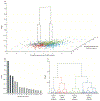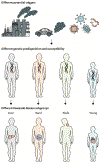Subgroups of children with Kawasaki disease: a data-driven cluster analysis
- PMID: 37598693
- PMCID: PMC10756500
- DOI: 10.1016/S2352-4642(23)00166-9
Subgroups of children with Kawasaki disease: a data-driven cluster analysis
Abstract
Background: Although Kawasaki disease is commonly regarded as a single disease entity, variability in clinical manifestations and disease outcome has been recognised. We aimed to use a data-driven approach to identify clinical subgroups.
Methods: We analysed clinical data from patients with Kawasaki disease diagnosed at Rady Children's Hospital (San Diego, CA, USA) between Jan 1, 2002, and June 30, 2022. Patients were grouped by hierarchical clustering on principal components with k-means parcellation based on 14 variables, including age at onset, ten laboratory test results, day of illness at the first intravenous immunoglobulin infusion, and normalised echocardiographic measures of coronary artery diameters at diagnosis. We also analysed the seasonality and Kawasaki disease incidence from 2002 to 2019 by subgroup. To explore the biological underpinnings of identified subgroups, we did differential abundance analysis on proteomic data of 6481 proteins from 32 patients with Kawasaki disease and 24 healthy children, using linear regression models that controlled for age and sex.
Findings: Among 1016 patients with complete data in the final analysis, four subgroups were identified with distinct clinical features: (1) hepatobiliary involvement with elevated alanine transaminase, gamma-glutamyl transferase, and total bilirubin levels, lowest coronary artery aneurysm but highest intravenous immunoglobulin resistance rates (n=157); (2) highest band neutrophil count and Kawasaki disease shock rate (n=231); (3) cervical lymphadenopathy with high markers of inflammation (erythrocyte sedimentation rate, C-reactive protein, white blood cell, and platelet counts) and lowest age-adjusted haemoglobin Z scores (n=315); and (4) young age at onset with highest coronary artery aneurysm but lowest intravenous immunoglobulin resistance rates (n=313). The subgroups had distinct seasonal and incidence trajectories. In addition, the subgroups shared 211 differential abundance proteins while many proteins were unique to a subgroup.
Interpretation: Our data-driven analysis provides insight into the heterogeneity of Kawasaki disease, and supports the existence of distinct subgroups with important implications for clinical management and research design and interpretation.
Funding: US National Institutes of Health and the Irving and Francine Suknow Foundation.
Copyright © 2023 The Author(s). Published by Elsevier Ltd. This is an Open Access article under the CC BY-NC-ND 4.0 license. Published by Elsevier Ltd.. All rights reserved.
Conflict of interest statement
Declaration of interests We declare no competing interests.
Figures




Comment in
-
Kawasaki disease: a new understanding of the clinical spectrum.Lancet Child Adolesc Health. 2023 Oct;7(10):672-673. doi: 10.1016/S2352-4642(23)00191-8. Epub 2023 Aug 17. Lancet Child Adolesc Health. 2023. PMID: 37598694 No abstract available.
References
-
- Newburger JW, Takahashi M, Burns JC. Kawasaki disease. J Am Coll Cardiol 2016; 67: 1738–49. - PubMed
-
- Kawasaki T, Kosaki F, Okawa S, Shigematsu I, Yanagawa H. A new infantile acute febrile mucocutaneous lymph node syndrome (MLNS) prevailing in Japan. Pediatrics 1974; 54: 271–76. - PubMed
-
- Kato H, Koike S, Yamamoto M, Ito Y, Yano E. Coronary aneurysms in infants and young children with acute febrile mucocutaneous lymph node syndrome. J Pediatr 1975; 86: 892–98. - PubMed
-
- Onouchi Y The genetics of Kawasaki disease. Int J Rheum Dis 2018; 21: 26–30. - PubMed
Publication types
MeSH terms
Substances
Grants and funding
LinkOut - more resources
Full Text Sources
Medical
Research Materials

